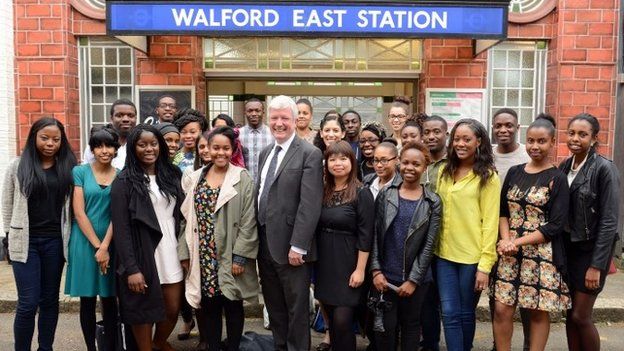EastEnders 'almost twice as white' as real East End
- Published

BBC soap EastEnders is "almost twice" as white as the real east London, Diane Coyle, the acting head of the BBC Trust, said in a speech in on Monday.
Ms Coyle said it would be "daft" for the show to be a "perfect replica" of the real world.
But she added it was "important to ask whether the BBC can do more in its popular output to provide an authentic portrayal of life in modern Britain".
The population of EastEnders was also younger than in real life, she said.
Ms Coyle is in the running to be head of the BBC Trust after Lord Patten stepped down due to ill health.
The BBC's audience council in England compared the population of Walthamstow in east London with Walford, the fictional home of EastEnders.
The figures suggested there were nearly twice as many white people living in Walford - E20 - as in real life E17, while the population of EastEnders tends to be younger than their real-life counterparts and more likely to have been born in the UK.
It is not the first time that Black, Asian and minority ethnic representation (BAME) in EastEnders has been called into question.
The soap's former boss, John Yorke, said EastEnders "may be significantly white compared with the real East End" back in May 2011.
At the time, he added that it was "considerably more multicultural than it was even five years ago and is easily the most multicultural show on telly now".
The BBC responded to Ms Coyle's comments by saying: "We agree with the trust that EastEnders has one of the most diverse casts on British television and that it would be daft to suggest that the programme needs to be a perfect replica of a particular postcode.
"As announced by [director general] Tony Hall last week, the BBC has plans to lead the industry on diversity, both on and off screen."
Ms Coyle also asked for improvements in BBC One's output across the board.
Speaking at the London School of Economics, she said that according to BBC research, BBC One, the home of EastEnders, "plays it too safe in parts of its peak-time schedule".
"BBC One is greatly appreciated. But it can sometimes feel too predictable. Its viewers expect still more from it," she added.
The BBC said that the channel reaches 76% of the population, or 44 million people each week.
"These audiences are clearly finding a huge amount that informs, educates and entertains them," it said.
"We continually strive to deliver new and original programmes and it has been our consistent ability to do this over the years which has made BBC One Britain's most-watched and loved channel."
The BBC Trust will set out in more detail what it would like the corporation to do next month.
Ms Coyle also said it was a priority for the BBC to increase the number of women on air.
Her comments follow the BBC's announcement last week to have greater BAME representation on and off air.
The BBC will put £2.1m into a fund intended to help BAME talent, on and off screen, to develop new programmes.
BBC targets call for about one in six people (15%) on-air to be from BAME backgrounds within three years - an increase of nearly 5%.
Delivering a lecture to Bafta in March, comedian and actor Lenny Henry said funds should be set aside to boost the presence of BAME people in the broadcasting industry.
He put the presence of those from BAME backgrounds in the creative industry at 5.4%.
He described this as "an appalling percentage because the majority of our industry is based around London where the black and Asian population is 40%."
He added that the situation behind the camera was also "patchy".
On Tuesday, Henry is giving evidence at a culture, media and sport committee on his proposals.
- Published20 June 2014
- Published18 March 2014
- Published10 May 2011